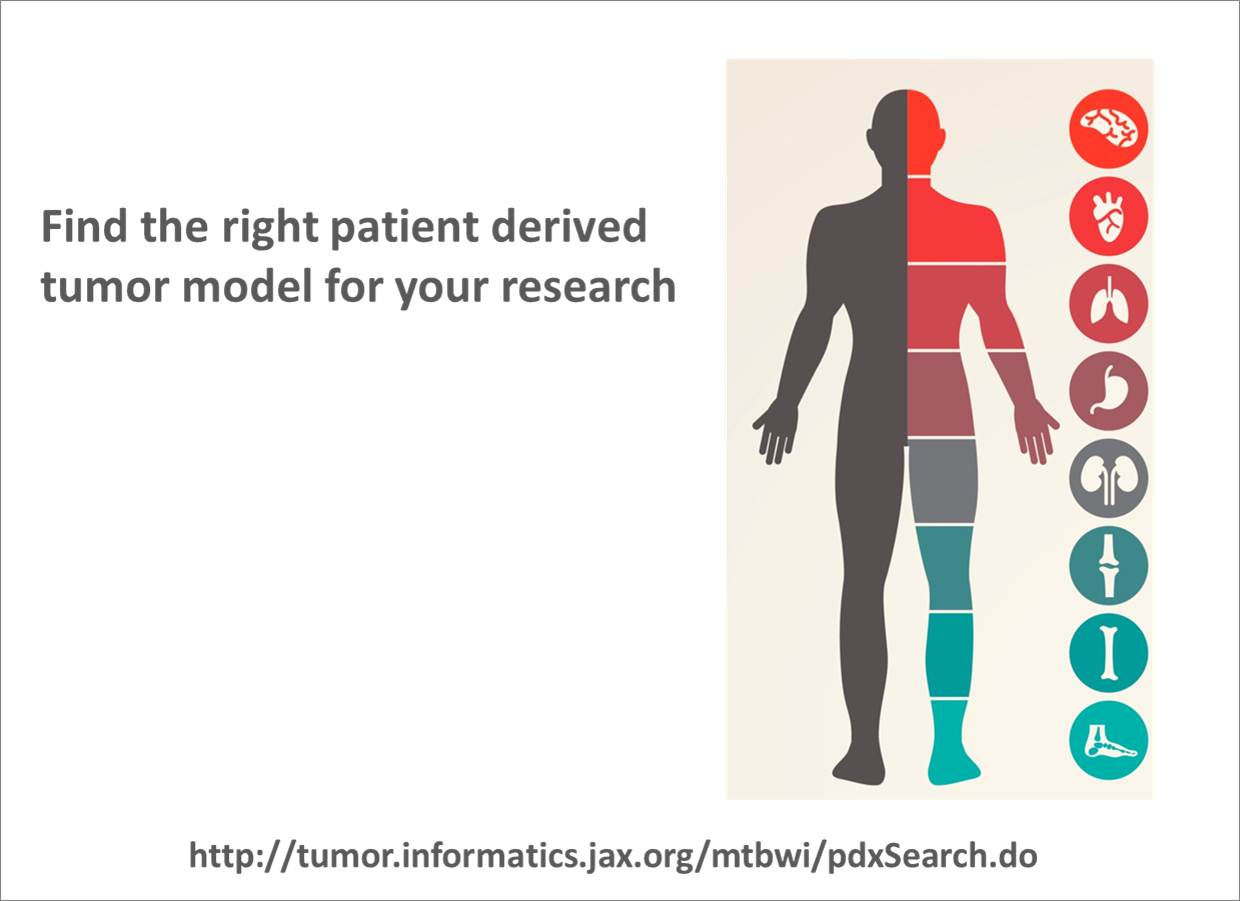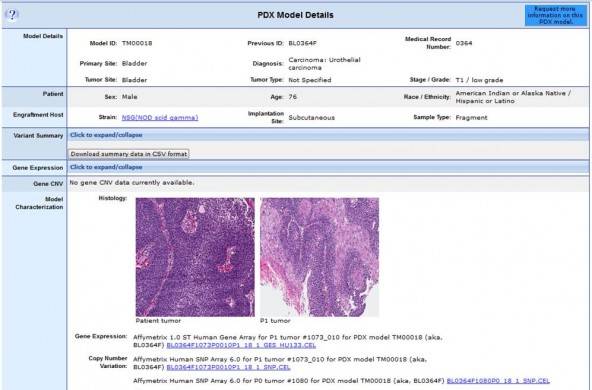
A new online resource, the Patient-Derived Xenograft Search Form was added to the Mouse Tumor Biology Database (MTB) to warehouse the information available for JAX’s patient-derived xenografts (PDX) models.
Mice engrafted with PDX – low passage primary tumors harvested from human cancer patients – offer exciting new prospects for in vivo cancer biology studies and pre-clinical cancer drug efficacy testing. The Jackson Laboratory has partnered with more than 20 cancer clinics to provide access to a wider range of PDX cancer models at earlier passage numbers (no less than P3) than any other PDX resource available today. More than 200 PDX oncology models from treatment naive and resistant patients have been established in our highly immunodeficient NSG (005557) mouse strain, and more are under development.
The Patient-Derived Xenograft Search Form: Multiple Search Strategies
The Patient-Derived Xenograft Search Form has been designed to allow searching for PDX models by several criteria:
- Primary cancer site: This search can be further limited to only return results for models with available drug response data or tumor growth curves.
- Diagnosis: Search based on tumor characteristics (e.g. adenocarcinoma, blastoma, sarcoma, etc.)
- Gene Variants: Search for tumors that express specific gene variants (eg. KRASG12D, KRASG12V, or KRASQ61H).
- Gene Expression: For many of our PDX tumors, gene expression data is available. Using this option, you can search for models that express either high or low levels of specific oncogenic or other proteins.
- Copy Number Variation: Search for tumors for which the dosage of a particular gene is either amplified due to duplication or reduced due to deletion.
Moreover, all of these searches can be combined to identify models with very specific characteristics: for example, you can search for all models that are derived from lung, or limit the search to only find those derived from lung that also express the KRASG12D variant.
You also can choose multiple options for each list; for example, you can search for both lung and colon tumor models that express KRAS variants.
What else?
For many models, additional information is available, including:
- Patient data: For example, age, sex and ethnicity
- Histology data: Histochemical images are available that allow morphological comparisons of the P0-passaged PDX tumor and the primary tumor.
- Tumor growth curves: Tables are available that compare the growth rates of tumors within a specific class (e.g. lung, breast, prostate).
The database is still very much a work in progress: some features have not yet been implemented, and not all data is available. For example, the patient’s clinical and treatment history is available for many of the PDX tumors, but this data has not yet been uploaded into the database. Our Technical Information Services (TIS) group, however, can provide this data on demand. Indeed, on the detail page for each model is a link to send a request to TIS for any additional information about it.

The Promise of PDX Cancer Models
PDX cancer models offer several advantages over models based on human cancer cell lines:
1. Tumor fidelity
Because they have only been passaged a few times, PDX tumors are more representative of the tumors present in current cancer patients. In contrast, many established tumor cell lines have been passaged for many generations, which typically results in cells with the highest proliferation rates dominating the cultures. These highly proliferative cells do not necessarily reflect the characteristics of the tumors from which they were derived.
2. Heterologous tumor fragments versus cellular monocultures
Most PDX models are tumor fragments made up of heterologous cells. In contrast, human cancer cell lines tend to be monocultures of a single cell type. In PDX models, the presence of non-tumorigenic cells in the tumor fragments may support the development of tumors within a stromal milieu more similar to that of the primary tumor. Cancer cell lines do not develop in the context of these stromal interactions unless engrafted orthotopically.
By displaying characteristics that more accurately reflect the tumors carried in human cancer patients, JAX PDX models promise to aid in the development of preclinical therapies that are more likely to demonstrate efficacy when transferred to the clinic. The JAX PDX Resource and Patient-Derived Xenograft Search Form will prove invaluable for helping cancer researchers identify and choose the best models with which to test anti-tumorigenic compounds.